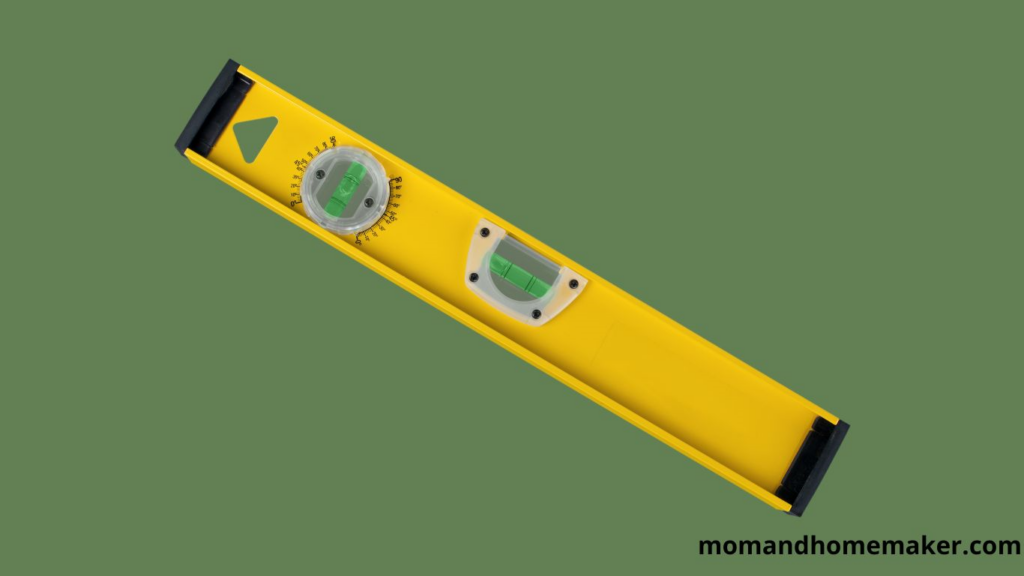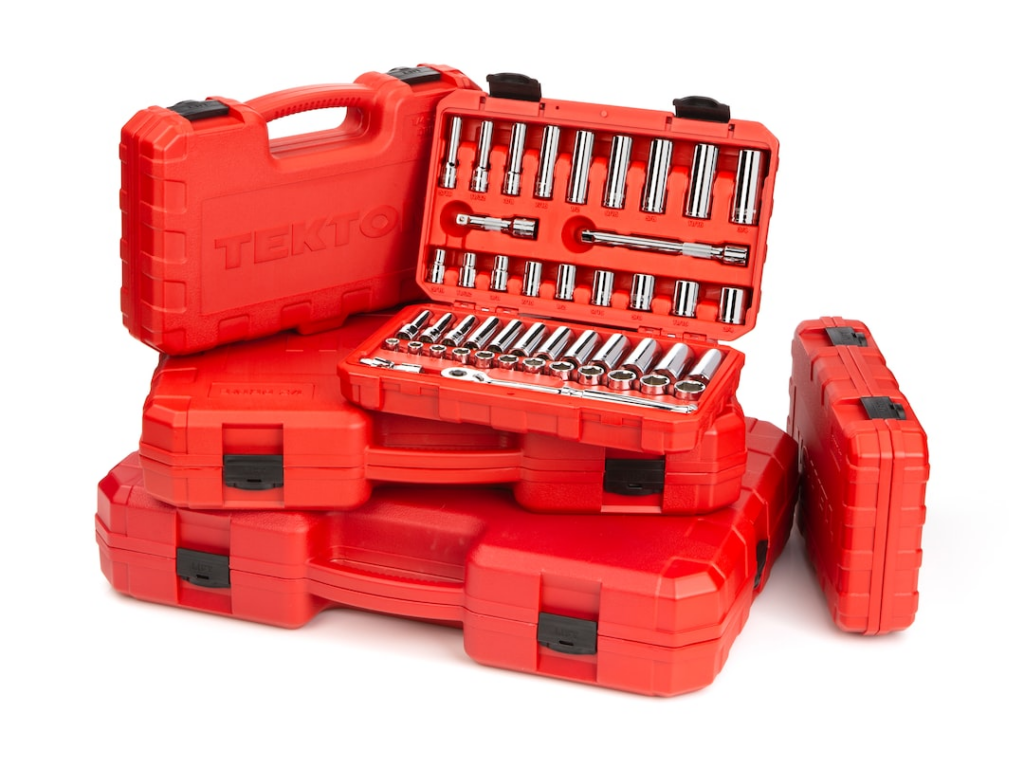Maintaining a home can sometimes feel like a never-ending task. From routine maintenance to unexpected repairs, it’s important to be prepared for anything that comes your way. The key to successful home maintenance lies in having the right tools at your disposal.
From power drills to screwdriver sets, an adjustable wrench to a hammer, these must-have tools will help you tackle any repair or project. With a tape measure, chisel, pipe wrench, and safety goggles, you’ll be well-equipped to handle any job.
Don’t forget your work gloves – let’s get started.
Power Drill
One essential tool for home maintenance is your power drill. This versatile tool has a range of uses that can make your DIY projects a breeze. From drilling holes to driving screws, a power drill is a must-have for any homeowner.
When using a power drill, it’s important to prioritize safety. Always wear protective goggles to shield your eyes from flying debris and use clamps or a vice to secure your workpiece.
Regular maintenance is crucial to keep your power drill in top shape. Clean the chuck and gears regularly and lubricate the moving parts to ensure smooth operation.
When it comes to brands, reputable options like Dewalt, Bosch, and Makita are known for their reliability and durability.

Screwdriver Set
You will need a versatile screwdriver set for your home maintenance tasks. A screwdriver set is an essential tool that will come in handy for a variety of jobs around the house. Here are three reasons why you should invest in a good quality screwdriver set:
- Screwdriver Types: A screwdriver set typically includes various types of screwdrivers, such as flathead, Phillips, and Torx. Having different types of screwdrivers will ensure that you have the right tool for any screw you encounter during your maintenance tasks.
- Screwdriver Sizes: Different screws come in different sizes, and having a set of screwdrivers with various sizes will allow you to tackle any size of the screw head. This versatility is crucial, as using the wrong-sized screwdriver can damage the screw or strip its head.
- Screwdriver Uses: A screwdriver set isn’t only useful for tightening or loosening screws. It can also be used for a range of other tasks, such as prying open paint cans, scraping off old paint, or removing electrical outlet covers.
To ensure the longevity of your screwdriver set, proper maintenance and care are essential. Make sure to clean your screwdrivers after each use, store them in a dry place, and periodically lubricate the pivot points to keep them working smoothly.
Investing in a high-quality screwdriver set will save you time and frustration when tackling home maintenance tasks. With the right set of screwdrivers at your disposal, you’ll feel confident and capable of handling any project that comes your way.

Adjustable Wrench
To effectively tackle home maintenance tasks, having an adjustable wrench is crucial. This versatile tool allows you to tighten or loosen a variety of nuts and bolts with ease. Proper usage of the adjustable wrench involves selecting the correct size for the job at hand. Ensure the jaws of the wrench are tightly gripping the fastener to prevent slipping and potential injuries.
There are different types of adjustable wrenches available, including the open-end adjustable wrench and the crescent adjustable wrench. The open-end adjustable wrench is ideal for tight spaces, while the crescent adjustable wrench offers a wider range of sizes and is more commonly used.
Maintenance tips for your adjustable wrench include keeping it clean and dry, lubricating the moving parts regularly, and storing it in a dry place to prevent rust. If your adjustable wrench isn’t functioning properly, some common problems may include loose jaws or difficulty adjusting the size. In such cases, it’s advisable to consult the manufacturer’s instructions or seek professional help.
When using an adjustable wrench, safety precautions should always be observed. Make sure the wrench is fully engaged with the fastener before applying force, and avoid using it on rounded or damaged fasteners as they may cause the wrench to slip and result in injury.

Hammer
A hammer is an essential tool for completing home maintenance tasks. It’s a versatile tool that can be used for various purposes, making it a must-have in your toolbox. Here are three reasons why a hammer should be a part of your home maintenance arsenal:
- Versatility: A hammer can be used for a wide range of tasks, such as driving nails into walls or furniture assembly. It’s also handy for removing nails or other fasteners, making it a versatile tool for both construction and repair projects.
- Precision: When it comes to delicate tasks that require a gentle touch, a hammer can be your best friend. Its weighted head allows for controlled strikes, ensuring that you can drive nails or make adjustments with precision.
- Efficiency: Compared to other tools like a power drill or screwdriver set, a hammer offers a quick and efficient way to get the job done. It requires no batteries or power source, making it readily available whenever you need it.
When using a hammer, it’s important to consider safety precautions. Always wear protective eyewear and ensure a secure grip on the handle to prevent accidents. With a hammer in hand, you’ll be well-equipped to tackle various home maintenance tasks with ease.

Tape Measure
To accurately measure and plan for your home maintenance projects, it’s essential to have a tape measure in your toolbox. Measuring accuracy is crucial when it comes to home improvement tasks, and choosing the right tape measure is key to achieving precise measurements.
When selecting a tape measure, look for one that has clear markings and a locking mechanism to hold the tape in place. This will ensure that your measurements are accurate and consistent.
In addition to its primary function, a tape measure can also be used in creative ways for home improvement projects. For example, you can use it to create straight lines for painting or to measure and install shelves and furniture. The versatility of a tape measure makes it an indispensable tool for any homeowner.
While a tape measure is the go-to tool for most measuring tasks, there are alternatives available. Laser distance measurers and digital measuring tools offer convenience and precision, but they may not be suitable for all situations.
It’s important to assess your specific needs and choose the measuring tool that best fits your requirements. To keep your tape measure easily accessible and organized, consider using a tool belt or a dedicated storage container.
This will prevent it from getting lost or tangled with other tools, saving you time and frustration. Digital tape measures have become increasingly popular in recent years. They offer benefits such as easy-to-read digital displays and the ability to store and recall measurements.
If you frequently undertake home maintenance tasks, investing in a digital tape measure could streamline your projects and provide added convenience.

Pliers
When it comes to home maintenance, an essential tool to have in your toolbox is a pair of pliers. Pliers are versatile hand tools that can be used for a variety of tasks around the house. Here are some uses and techniques for pliers:
- Gripping and holding: Pliers are great for gripping and holding objects securely. Whether you’re tightening a nut or pulling out a stubborn nail, pliers provide the necessary grip and leverage.
- Cutting and stripping wire: Many types of pliers, such as wire cutters and needle-nose pliers, have built-in cutting edges. These are perfect for cutting and stripping wires during electrical repairs or installations.
- Bending and shaping: Pliers with flat or round jaws can be used to bend and shape metal or other materials. This comes in handy when you need to make adjustments or modifications to various objects.
There are different types of pliers, each designed for specific purposes. Some common types include slip-joint pliers, needle-nose pliers, and locking pliers. When choosing pliers for your home maintenance needs, consider the task at hand and select the appropriate type based on its features and capabilities.
Pliers can solve many common problems around the house. From fixing leaky pipes to repairing small appliances, pliers are a must-have tool for any DIY enthusiast. However, it’s important to use them safely. Here are some safety tips to keep in mind:
- Always wear safety glasses or goggles to protect your eyes from flying debris.
- Use pliers with insulated handles when working with electrical wires.
- Avoid using excessive force, as it can cause the pliers to slip and result in injury.
- Keep your fingers clear of the pliers’ jaws to prevent accidental pinching or crushing.

Utility Knife
Make sure you have a utility knife in your toolbox for all your home maintenance needs. A utility knife is a versatile and essential tool that can be used for a variety of tasks around the house. It’s important to prioritize knife safety when using a utility knife at home. Here are some tips and tricks to keep in mind:
- Always keep the blade retracted when not in use to prevent accidents.
- Use a sharp blade to reduce the risk of slips and ensure smooth cuts.
- Hold the knife firmly and apply even pressure when cutting to maintain control.
- Cut away from your body and keep your fingers clear of the blade.
When choosing a utility knife for your home projects, consider the following factors:
- Blade type: Opt for a retractable blade for added safety and convenience.
- Handle grip: Look for a knife with an ergonomic handle for comfortable use.
- Blade change mechanism: Choose a knife with a quick and easy blade replacement system for efficiency.
Apart from the obvious uses like cutting boxes and opening packages, a utility knife can also be creatively used in home maintenance. Here are some ideas:
- Removing old caulk from bathtubs and sinks.
- Trimming wallpaper edges for a neat finish.
- Cutting through carpet or vinyl flooring during installation.
To properly maintain and care for your utility knife, follow these steps:
- Keep the blade clean and free from debris.
- Regularly oil the moving parts to ensure smooth operation.
- Replace the blade when it becomes dull or damaged.
In some cases, a utility knife may not be suitable for certain home maintenance tasks. Here are some alternatives you can consider:
- Scissors: Use scissors for cutting fabric or other materials that require more precision.
- Hacksaw: For cutting through metal pipes or other heavy-duty materials.
Remember to always prioritize safety when using any tool, and a utility knife is no exception. By choosing the right knife, using it correctly, and taking proper care of it, you can efficiently tackle various home maintenance projects.

Level
Check the bubble on your level to ensure that surfaces are perfectly straight. A level is an essential tool for any DIY enthusiast or homeowner. It helps you achieve accurate and level surfaces, ensuring that your projects turn out perfectly. Here are some important tips and techniques to keep in mind when using a level:
- Hold the level firmly against the surface you want to level.
- Use a pencil to mark the areas that need adjustment.
- Make small adjustments at a time and recheck with the level to avoid overcorrection.
Having the right leveling tools is crucial for any home maintenance project. They help you achieve professional-looking results and prevent costly mistakes. However, there are some common leveling mistakes to watch out for:
- Not checking the level for accuracy before starting a project.
- Neglecting to recheck the level periodically as you work.
- Failing to adjust the level properly, resulted in uneven surfaces.
Whether you’re hanging shelves, installing cabinets, or laying tiles, using a level will ensure your project is precise and visually appealing. Remember these tips for using leveling tools:
- Start with a reliable and accurate level.
- Double-check your work to achieve the desired level.
- Take your time and make small adjustments as needed.
With these leveling techniques and tips, you’ll be able to tackle any DIY leveling project with confidence and achieve professional results.

Allen Wrench Set
An Allen wrench set is an essential tool for tackling various home maintenance tasks. These versatile wrenches, also known as hex keys, are used to tighten or loosen screws and bolts with hexagonal sockets. Proper usage of an Allen wrench set involves selecting the right size for the job at hand.
These sets typically come in a range of sizes, ensuring that you have the correct wrench for any task. It’s important to choose the right size to avoid damaging the screw or bolt.
Maintenance tips for an Allen wrench set are relatively simple. After each use, wipe the wrenches clean and store them in a dry place to prevent rust. Regularly inspect the wrenches for any signs of wear or damage, and replace any worn-out wrenches to maintain their effectiveness.
The common applications of an Allen wrench set are vast. From assembling furniture to repairing bicycles, these wrenches are indispensable. They’re commonly used in plumbing, automotive, and electrical work as well.
When it comes to Allen wrench sets, quality matters. Investing in a high-quality set will ensure durability and accuracy. Cheap or low-quality wrenches may strip screws or bolts, making the task more difficult and potentially causing damage. A good quality Allen wrench set will last you for years and provide reliable performance.

Socket Set
You’ll need a versatile socket set to tackle a variety of home maintenance tasks. A socket set is a must-have tool that can help you with everything from tightening bolts to assembling furniture.
Here are some discussion ideas, uses, maintenance tips, buying guide, and safety precautions for socket sets:
- Discussion ideas:
- Different types of socket sets are available in the market.
- The advantages of using a socket set over other tools.
- How to choose the right socket set for your needs.
- Socket set uses:
- Loosening or tightening nuts and bolts.
- Repairing or assembling furniture.
- Working on automotive maintenance and repairs.
- Socket set maintenance tips:
- Keep your socket set clean and free from dirt and debris.
- Regularly inspect the sockets for any signs of wear or damage.
- Lubricate the moving parts of the socket set to ensure smooth operation.
- Socket set buying guide:
- Consider the quality and durability of the sockets and ratchets.
- Look for a set that includes a wide range of socket sizes.
- Check for additional features like a storage case or extension bars.
- Socket set safety precautions:
- Always wear safety goggles when using a socket set.
- Use the appropriate socket size for the job to avoid damaging the fasteners.
- Be cautious of applying excessive force, as it may cause the socket to slip or break.

Stud Finder
Finding studs: Tips and tricks for using a stud finder effectively will ensure that you hang your heavy items securely and avoid damaging your walls.
Different types of stud finders: Which one is right for your home? There are magnetic stud finders that detect metal fasteners, electronic stud finders that use sensors to locate changes in density, and even wall scanners that can detect not only studs but also live wires and pipes. It’s important to choose the right type of stud finder based on the materials in your walls and your specific needs.
Common mistakes to avoid when using a stud finder include not calibrating it properly, not sliding it slowly and steadily across the wall, and not marking the stud location accurately.
Using a stud finder for more than just hanging pictures: Creative uses for this handy tool include finding studs for installing shelves, mounting TVs, and even adding support for heavy mirrors.
Stud finder technology: What’s new and improved in the world of stud finding? Some stud finders now come with built-in levelers, LCD screens, and even smartphone connectivity for enhanced accuracy and convenience.
Having a stud finder in your toolbox will make your home maintenance tasks easier and more efficient.

Caulking Gun
For your home maintenance tasks, another essential tool to have in your toolbox is the caulking gun, which will seamlessly continue the discussion on effective home maintenance tools. A caulking gun is a handheld tool that dispenses caulking or sealant to fill gaps or cracks in various surfaces.
Here are some important tips and information to help you maintain your caulking gun and make the most of its functionality:
- Caulking Gun Maintenance Tips:
- Regularly clean the gun after each use to prevent dried caulk from clogging the nozzle.
- Store the gun in a cool, dry place to prevent rusting or damage.
- Replace worn-out parts such as the plunger or nozzle to maintain smooth operation.
- Best Caulking Gun Brands:
- Dripless
- Newborn Brothers
- Albion Engineering
- How to Choose a Caulking Gun:
- Consider the type of material you’ll be using (silicone, acrylic, etc.), and choose a gun that’s compatible with it.
- Look for a gun with an adjustable pressure mechanism for precise control.
- Opt for a gun with a sturdy construction and ergonomic grip for comfortable handling.
Understanding the difference between a caulking gun and a sealant gun is crucial. While both tools serve similar purposes, a caulking gun is specifically designed for dispensing caulk, whereas a sealant gun is more versatile and can handle a wider range of sealant types.
Mastering caulking gun techniques is essential for achieving professional-looking results. Maintain a steady hand and apply even pressure to ensure a smooth and consistent bead.
Use masking tape to create clean lines and remove it immediately after caulking to achieve sharp edges. Practice on scrap materials before tackling the actual task to gain confidence and improve your technique.
With these maintenance tips, brand recommendations, selection advice, and application techniques, you can confidently wield a caulking gun and achieve excellent results in your home maintenance projects.

Paintbrushes
When maintaining your home, regularly using paintbrushes will ensure a fresh and vibrant look. To keep your paintbrushes in good condition, it’s important to practice proper maintenance.
After each use, remove excess paint by gently scraping it off the bristles. Then, rinse the brush with warm water and mild soap, making sure to remove all paint residue. Avoid using harsh chemicals as they can damage the bristles. Once clean, reshape the brush and let it air dry before storing it in a dry place.
There are different types of paintbrushes available, each designed for specific tasks. Flat brushes are great for large, flat surfaces, while angled brushes are ideal for cutting in and reaching tight corners. For detailed work, consider using a round brush. It’s important to choose the right brush size for the job at hand. A larger brush covers more area quickly, while a smaller brush allows for greater precision.
When using a paintbrush, hold it at a slight angle and apply even pressure as you move it across the surface. Start from the top and work your way down to prevent drips and streaks. For a smooth finish, use long, smooth strokes in the same direction.
After you have finished painting, clean your brushes thoroughly to extend their lifespan. Use warm water and mild soap to remove all paint residue. Gently comb the bristles to remove any remaining paint. Finally, let the brushes air dry before storing them.
Choosing the right paintbrush for the job is crucial for achieving the desired results. Consider the type of paint you’re using, the surface you’re painting, and the size of the area. For water-based paints, synthetic bristle brushes work well, while natural bristle brushes are better suited for oil-based paints.

Wire Cutters
One essential tool you need for home maintenance is a pair of wire cutters. Wire cutters are versatile tools that can be used for a variety of tasks around the house.
Here are some discussion ideas about wire cutters that aren’t relevant to the other tools listed above:
- Wire cutting techniques: Wire cutters are designed to cut through different types of wires, such as electrical wires, cables, and even thin metal wires. It’s important to learn proper techniques, such as positioning the wire properly in the cutter jaws and applying steady pressure to make clean cuts.
- Different types of wire cutters: There are various types of wire cutters available, such as diagonal cutters, lineman’s pliers, and needle-nose pliers. Each type has its own specific purpose, so it’s important to choose the right one for the task at hand.
- Safety tips when using wire cutters: Always wear safety goggles to protect your eyes from flying debris. Make sure to use insulated handles when working with live electrical wires. And remember to cut wires away from your body to avoid accidents.
- Common uses for wire cutters around the house: Wire cutters can be used for tasks like trimming electrical wires, cutting zip ties, or even removing nails from walls. They’re handy tools to have for small repairs and DIY projects.
- How to maintain and care for wire cutters: After each use, wipe the blades clean and apply a light coat of oil to prevent rust. Store them in a dry place to maintain their sharpness and prolong their lifespan.
Wire cutters are an essential tool for any homeowner, allowing you to tackle a wide range of tasks with ease and precision. With proper techniques, safety precautions, and regular maintenance, your wire cutters will be a reliable companion in your home maintenance endeavors.

Flashlight
To ensure proper visibility during home maintenance tasks, equip yourself with a reliable flashlight. A flashlight is an essential tool that can help you see in dark and hard-to-reach areas. There are many uses for a flashlight during home maintenance, such as inspecting wiring, plumbing, or HVAC systems. It can also come in handy when searching for lost items or navigating through power outages.
Flashlight maintenance is important to ensure that it’s always ready for use. Regularly check the batteries and replace them as needed. It’s also a good idea to clean the flashlight’s lens and contacts to prevent dirt or corrosion from affecting its performance. Storing the flashlight in a dry and cool place will help prolong its lifespan.
Choosing the right flashlight is crucial for effective home maintenance. Look for one that’s durable, waterproof, and has a bright and adjustable beam. Consider the size and weight, as you want a flashlight that’s comfortable to hold and carry around.
If you encounter any issues with your flashlight, troubleshooting can help identify and resolve the problem. Check the batteries, and make sure they’re properly inserted and not expired. Clean the contacts and replace any damaged parts if necessary.
Flashlight safety is essential to prevent accidents. Always handle a flashlight with clean and dry hands to avoid electrical shocks. Don’t shine the flashlight directly into someone’s eyes as it can cause temporary blindness. And remember to turn off the flashlight when not in use to conserve battery life.
Pry Bar
If you frequently find yourself needing to remove nails or pry open stubborn objects during your home maintenance tasks, a pry bar is an indispensable tool to have. Whether you’re a seasoned DIY enthusiast or just starting out, a pry bar can make your home projects much easier.
Here are some discussion ideas to help you understand the uses, types, and tips for using a pry bar effectively:
- Uses of pry bar in home maintenance:
- Removing nails: A pry bar’s primary function is to remove nails from wood, walls, or any other surface.
- Opening crates and boxes: A pry bar’s flat edge can easily pry open crates or boxes that are sealed shut.
- Demolition work: When you need to break apart materials or remove old fixtures, a pry bar can be your best friend.
- Different types of pry bars and their applications:
- Flat pry bar: Ideal for general prying and nail removal.
- Crowbar: Great for heavy-duty tasks and demolition work.
- Cat’s paw pry bar: Designed specifically for removing nails and staples.
- Tips for using a pry bar effectively and safely:
- Use protective gloves to prevent injury.
- Position the pry bar at an angle for maximum leverage.
- Start with small prying motions to avoid damaging the surface.
With these tips in mind, choosing the right pry bar for your home projects becomes easier. Consider the size, material, and specific task requirements when making your selection.
if you’re feeling creative, you can repurpose a pry bar for various DIY projects like opening paint cans or even creating unique wall art. The possibilities are endless when you have a versatile tool like a pry bar at your disposal.

Trowel
To continue your home maintenance tasks seamlessly, another essential tool to have is a trowel. A trowel is a versatile hand tool that’s commonly used for spreading and smoothing materials like cement, plaster, and mortar. It’s an indispensable tool for various home repairs and renovations.
There are different types of trowels available, each designed for specific tasks. For instance, a pointing trowel is perfect for filling cracks and joints, while a finishing trowel is ideal for achieving a smooth and even surface. It’s important to choose the right type of trowel for the job to ensure optimal results.
To maintain your trowel, clean it thoroughly after each use to remove any residue. You can use warm water and a stiff brush to scrub away any dried material. After cleaning, make sure to dry the trowel completely to prevent rusting. Additionally, store the trowel in a cool, dry place to avoid moisture damage.
When using a trowel for home repairs, it’s crucial to follow proper techniques. Apply even pressure and use smooth, sweeping motions to ensure an even finish. Avoid excessive force as it may cause cracks or damage to the surface.
Prioritize safety when using a trowel. Wear protective gloves and goggles to shield yourself from any potential hazards. Keep the trowel away from children and always handle it with care to prevent accidents.

Chisel
Now let’s move on to another essential tool for home maintenance: the chisel. Chisels are versatile tools that can be used for a variety of tasks around the house. Here are some important things to know about chisels:
- Chisel techniques: When using a chisel, it’s important to have the right technique. Always use a controlled and steady hand, applying pressure gradually to avoid any accidents. Make sure to use the appropriate size and type of chisel for the task at hand.
- Choosing the right chisel: There are different types of chisels available, each designed for specific tasks. For woodworking, a beveled-edge chisel is commonly used, while a cold chisel is more suitable for metalwork. Consider the material you’ll be working with and choose the chisel accordingly.
- Essential chisel safety tips: Safety is paramount when using a chisel. Always wear protective goggles to shield your eyes from flying debris. Keep your fingers away from the cutting edge and use a mallet or hammer to strike the chisel. Make sure to secure the material you’re working on to prevent it from moving.
Chisels can be used creatively in various home maintenance tasks. They’re great for removing old paint, trimming wood, or even creating intricate designs.
Lastly, it’s crucial to know how to sharpen a chisel properly. A dull chisel can be dangerous and less effective. Use a sharpening stone or honing guide to maintain a sharp edge, ensuring clean and precise cuts.

Pipe Wrench
Moving on from the chisel, another essential tool for home maintenance is the pipe wrench. When it comes to plumbing problems, a pipe wrench is indispensable. It allows you to tighten or loosen pipe fittings, making it a must-have for any DIY enthusiast or homeowner.
For common pipe problems, such as leaks or loose connections, a pipe wrench can be a lifesaver. With its adjustable jaws, you can easily grip and turn pipes of different sizes, providing the necessary torque to tighten or remove fittings.
When choosing the right pipe wrench, consider the size of the pipes you’ll be working with. Opt for a wrench with a longer handle for better leverage and a wider jaw opening for larger pipes. It’s also important to choose a wrench made from durable materials like steel or cast iron to ensure its longevity.
To maintain and care for your pipe wrench, keep it clean and dry after each use. Apply a thin layer of lubricant to prevent rust. Regularly check for any signs of wear or damage, and replace as needed.
If you don’t have a pipe wrench, there are alternatives you can use. A pair of adjustable pliers or a strap wrench can be effective in certain situations. However, for more serious pipe repairs or installations, a pipe wrench is the tool you’ll want to have in your arsenal.

Safety Goggles
When working on home maintenance tasks, it’s crucial to protect your eyes with a pair of safety goggles. Safety goggles, also known as safety glasses, are an essential tool for keeping your eyes safe from potential hazards. Here are some important points to consider when it comes to safety goggles:
- Importance and types of safety glasses:
Safety glasses are designed to provide protection against flying debris, chemicals, and other potential eye hazards. There are different types of safety goggles available, such as clear lenses for general use, tinted lenses for outdoor work, and goggles with anti-fog coatings for humid environments. - Choosing the right safety goggles for different tasks:
When selecting safety goggles, consider the specific task you’ll be performing. For example, if you’re working with chemicals, choose goggles that provide full eye coverage and are chemical-resistant. If you’re working outdoors, opt for goggles with UV protection. - How to care for and maintain safety goggles:
To ensure the longevity of your safety goggles, clean them regularly with mild soap and water. Avoid using harsh chemicals that can damage the lenses. Store them in a protective case when not in use to prevent scratches. - Safety goggles vs. other eye protection options:
While safety goggles provide comprehensive eye protection, there are other options available such as safety glasses, face shields, and welding helmets. Consider the specific task and level of protection required when choosing eye protection. - Tips for proper fit and comfort of safety goggles:
To ensure a proper fit, adjust the straps or nose pads of the goggles to fit securely on your face. Make sure they don’t obstruct your vision or cause discomfort. Replace any damaged or worn-out goggles to maintain the highest level of eye protection.
Protecting your eyes should be a top priority when it comes to home maintenance. Investing in a quality pair of safety goggles and following the proper care and maintenance guidelines will help keep your eyes safe from potential hazards. Stay vigilant and take the necessary precautions to ensure your eye safety while working on maintenance tasks at home.
Work Gloves
Continue to protect yourself during home maintenance tasks by wearing a pair of durable work gloves. Glove maintenance is crucial to ensure their longevity and effectiveness.
After each use, clean your gloves with mild soap and water, and allow them to air dry. Inspect them for any signs of wear and tear, such as holes or frayed edges, and replace them if necessary.
There are different types of work gloves available, each designed for specific tasks. For general tasks, opt for gloves made of leather or synthetic materials like nylon or neoprene. These provide good protection and dexterity. When working with chemicals or sharp objects, choose gloves that offer chemical resistance or cut resistance, respectively.
To choose the right work gloves, consider factors such as the level of protection required, the type of task you’ll be performing, and the fit of the gloves. Gloves that are too loose can cause accidents, while gloves that are too tight can restrict movement and cause discomfort.
It’s important to have work gloves suitable for different seasons. In colder weather, insulated gloves or gloves with thermal linings will keep your hands warm. In hotter weather, choose gloves that are breathable and lightweight to prevent excessive sweating.
Investing in the right work gloves won’t only protect your hands, but also make your home maintenance tasks more efficient and enjoyable.

Conclusion
Having the right tools for home maintenance is essential.
With a power drill, screwdriver set, adjustable wrench, hammer, tape measure, chisel, pipe wrench, safety goggles, and work gloves, you’ll be well-equipped for any task.
As the saying goes, ‘A stitch in time saves nine,’ investing in these must-have tools will save you time, money, and frustration in the long run.
Gear up and get ready to tackle those home maintenance projects with confidence and ease.

















